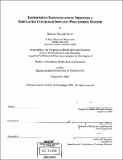| dc.contributor.advisor | Barry Vercoe. | en_US |
| dc.contributor.author | Reich, Rebecca Danielle, 1977- | en_US |
| dc.contributor.other | Massachusetts Institute of Technology. Dept. of Architecture. Program In Media Arts and Sciences. | en_US |
| dc.date.accessioned | 2011-04-25T15:48:43Z | |
| dc.date.available | 2011-04-25T15:48:43Z | |
| dc.date.copyright | 2002 | en_US |
| dc.date.issued | 2002 | en_US |
| dc.identifier.uri | http://hdl.handle.net/1721.1/62373 | |
| dc.description | Thesis (S.M.)--Massachusetts Institute of Technology, School of Architecture and Planning, Program in Media Arts and Sciences, 2002. | en_US |
| dc.description | Includes bibliographical references (p. 97-99). | en_US |
| dc.description.abstract | The signal processing used by cochlear implants is primarily designed to convey speech and environmental sounds, and can cause distortion of music. Although some studies of implanted listeners have demonstrated their limited ability to identify instruments, these results do not suggest whether the sound-processing system or the subjects' physiological state is the limiting factor. In this research, normal-hearing subjects determined the extent to which a simulation of the sound processing of a common cochlear implant degraded their ability to recognize instruments. The signal processing simulated in this study included bandpass filtering, rectification and lowpass filtering. Musical signals consisting of acoustic and synthetic solo instrument performances of short phrases were passed through the simulation, and presented to 25 normal-hearing participants as part of an instrument identification task. Eight acoustic and eleven synthesized common instrument timbres were used as input signals to the simulation and two rectification methods were studied for comparison purposes. Subjects were asked to identify the instrument presented, for the unaltered sounds and the sounds processed by the simulation. Identification scores for sounds heard through the simulation were significantly lower than those for unaltered sounds, due to the limited time and frequency information transmitted by the processing scheme. The results support the hypothesis that it is necessary to pursue alternative processing schemes for the implant, specifically intended for music-listening purposes. | en_US |
| dc.description.statementofresponsibility | by Rebecca Danielle Reich. | en_US |
| dc.format.extent | 107 p. | en_US |
| dc.language.iso | eng | en_US |
| dc.publisher | Massachusetts Institute of Technology | en_US |
| dc.rights | M.I.T. theses are protected by
copyright. They may be viewed from this source for any purpose, but
reproduction or distribution in any format is prohibited without written
permission. See provided URL for inquiries about permission. | en_US |
| dc.rights.uri | http://dspace.mit.edu/handle/1721.1/7582 | en_US |
| dc.subject | Architecture. Program In Media Arts and Sciences. | en_US |
| dc.title | Instrument identification through a simulated cochlear implant processing system | en_US |
| dc.type | Thesis | en_US |
| dc.description.degree | S.M. | en_US |
| dc.contributor.department | Program in Media Arts and Sciences (Massachusetts Institute of Technology) | |
| dc.identifier.oclc | 52033699 | en_US |
